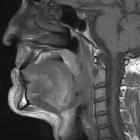Oropharyngeal squamous cell carcinoma






Oropharyngeal squamous cell carcinoma (OPSCC) is the most common type of head and neck cancer in the Western world . Typically it will be further categorized based on the specific anatomical location involved within the oropharynx, as this may affect prognosis and modality of treatment.
Epidemiology
Epidemiology and risk factors are similar to elsewhere in the aerodigestive tract. Traditionally, the major risk factors for OPSCC are alcohol and tobacco .
These remain important risk factors, however, in recent years there has been an increasing incidence of OPSCC caused by human papillomavirus (HPV). HPV associated OPSCC tend to occur in a younger population group, and may feature more rapid growth of disease and more pronounced locoregional lymph node involvement . However, they also tend to respond better to chemoradiotherapy treatment and carry a better overall prognosis . For this reason, OPSCC is often subcategorised into HPV-associated (or p16 positive) or non-HPV-associated (or p16 negative) OPSCC. HPV positive cases of OPSCC are typically caused by HPV subtype 16, which is also the subtype associated with cervical cancer.
Clinical presentation
OPSCC has a varied presentation depending on the specific anatomical site of origin. Common presenting symptoms include odynophagia and dysphagia. Because of the propensity for HPV-associated OPSCC to have early nodal involvement, they may also present with a neck mass.
Pathology
As per the 2017 8 edition American Journal Committee on Cancer (AJCC) guidelines, OPSCC are categorized into HPV/p16 positive and HPV/p16 negative, as these are different patterns of disease and carry very different prognoses.
Location
Common subtypes of OPSCC include tonsil, base of tongue and soft palate, however, anywhere in the oropharynx can be involved. For the purposes of staging, the lingual surface of the epiglottis is excluded and considered part of the larynx, and the nasopharyngeal surface of the soft palate is considered part of the nasopharynx.
Staging
Radiographic features
CT
CT will typically show an asymmetric soft tissue mass with contrast enhancement within the aerodigestive tract. In more advanced disease there may be loss of normal fat planes as the tumor extends beyond its site of origin.
Careful assessment of neck lymph nodes is essential for OPSCC primary malignancies. Involved lymph nodes are usually referred to in terms of neck lymph node levels. Features of nodal involvement include short-axis diameter greater than 10 mm, asymmetry, and loss of fatty hilum. Metastatic lymph nodes may sometimes demonstrate cystic change or central necrosis . Signs of nodal extracapsular extension include loss of adjacent fat planes, irregular capsular enhancement, and ill-defined margins . HPV associated OPSCC have a high tendency for nodal metastasis, particularly within the level II nodal station. The most common cause of metastatic lymph node involvement within the level II region is metastasis from a p16 positive OPSCC .
Treatment and prognosis
Treatment options depend on the stage and location of the disease, as well as patient factors and suitability for different treatment options. The three primary modalities of radical treatment are surgery, radiotherapy and chemotherapy. Another systemic option that is a current area of active research is immunotherapy.
HPV positive OPSCC tends to have a much better prognosis than HPV negative OPSCC. The estimated 5-year survival for HPV positive OPSCC is 90%, compared with 40% for HPV negative cases .
Siehe auch:
und weiter:

 Assoziationen und Differentialdiagnosen zu Oropharynxkarzinom:
Assoziationen und Differentialdiagnosen zu Oropharynxkarzinom: